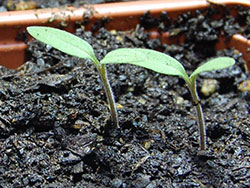Khursheed Mam
Colorado State University Extension Master Gardener in Larimer County
February 12, 2015

Winter is upon us and seems to be typical for Colorado—we have had both warm, sunny days and snow blanketing the ground. It is a time of year when gardeners, having had some respite from fall clean up, start impatiently waiting to see new growth and color in their gardens indicating the return of spring. While there are many things gardeners can do inside (to plan) or outside when weather permits to get the garden ready for a new growing season, this quiet season is a perfect time to focus on enjoying elements of the garden indoors.
Perhaps the easiest approach is to visit the greenhouse of one of the many local nurseries or Fort Collins local botanical garden, the Gardens on Spring Creek. Despite it being the midst of winter you will find an abundance of scents and sights to cheer you and you might find yourself taking home a plant or two you couldn’t resist. Not only will you find many plants to choose from, unique and colorful containers provide options for individualization of your selection(s). Taking a class at one of these venues and enjoying pictures of gardens is another simple way to take a break from the winter landscape. For the more enterprising, options such as forcing bulbs for indoor blooms, growing an indoor herb garden or starting seeds indoors for subsequent outdoor planting provide other options. For information on starting seeds indoors, visit PlantTalk Colorado and read script #1034.
“Forcing” refers to the process of artificially cooling bulbs for a period of time and then gradually exposing them to a warm and moist environment (in essence mimicking winter and the transition to spring). While many bulbs may be forced (e.g. crocus, hyacinths, grape hyacinths, Dutch iris and tulips) they also require a long chilling period (approximately 6 to 12 weeks at a temperature of approximately 40 degrees), so the process is best started in early winter. If you didn’t plan, do not despair, you could still have a blooming amaryllis or paperwhites (Narcissus) in time for the Easter holiday as these can be planted indoors in containers without a chilling period.
To force bulbs, select a container that is about twice the depth of the bulb. After ensuring that the container has good drainage, plant the bulb(s) in soil or with decorative rocks/colored glass (paperwhites lend themselves to this) with their tips just barely visible at the top (amaryllis may have up to one half of the bulb exposed). After a thorough initial watering, water periodically to make sure the soil doesn’t dry out; if planting in rocks, water to the level of the base of bulb, but make sure the bulb isn’t submerged in standing water. For bulbs requiring a cooling period, keep the container in a cool/dark area (garage or basement) for a few weeks. The bulbs show no outward growth during this period, but should be developing a root system that will support blooms once exposed to a warm environment and watered regularly. For those who prefer a more immediate reward, purchase pre-potted and chilled bulbs that you can simply place in a sunny location, water and watch grow. For more on forcing or growing bulbs indoors refer to PlantTalk Colorado script #1319.
For those who prefer useful plants and enjoy cooking, a winter indoor herb garden may provide just the solution. Italian herb pots with thyme, basil, parsley, rosemary, sage among other selections are a common themed container. The plants can be individually planted in separate containers or together. Place in a warm spot in the home where the container will receive sunlight and water routinely each time the soil begins to dry out. Then watch the plants grow, snip and enjoy. For more information on growing herbs please refer to Colorado Master Gardener Garden Note #731.
As the weather warms up and we spend more time outside, many of the plants grown indoors in the winter can also be gradually transitioned to the outdoors in protected areas for the summer months giving the gardener twice the enjoyment.
The author has received training through Colorado State University Extension’s Master Gardener program and is a Master Gardener volunteer for Larimer County.
——————-
Larimer County is a county-based outreach of Colorado State University Extension providing information you can trust to deal with current issues in agriculture, horticulture, nutrition and food safety, 4-H, small acreage, money management and parenting. For more information about CSU Extension in Larimer County, call (970) 498-6000 or visit www.larimer.org/ext
——————-
Looking for additional gardening information? Check out the CSU Extension Horticulture Agent blog at www.csuhort.blogspot.com for timely updates about gardening around the state.
——————-
Visit PlantTalk Colorado ™ for fast answers to your gardening questions! www.planttalk.org PlantTalk is a cooperation between Colorado State University Extension, GreenCo and Denver Botanic Gardens.





